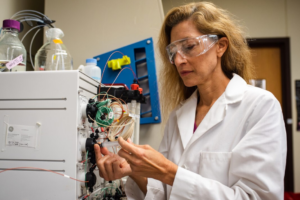It was four o’clock in the morning and still dark out when the cast and crew for Roots got on the bus to travel to a plantation in Louisiana for filming. With them was Daina Ramey Berry, an associate professor of history at The University of Texas at Austin.
Berry, an expert on 19th century American slave culture, was a historical consultant and technical adviser for A&E HISTORY’s re-imagining of the seminal miniseries Roots.
“I write about the institution of slavery, but I’m really interested in how the people experience it,” Berry said.As she walked the plantation, she spent a lot of time reflecting on how her senses echoed the moments slaves would have encountered on that land more than 150 years ago. She wondered, “How is it going to feel to walk barefoot in the fields, and when the fog lifts can you see the plants?”
Roots first premiered to an audience of more than 100 million viewers in 1977. People were glued to their televisions to follow the journey of one family and their will to survive and ultimately carry on their legacy despite hardship.

A&E HISTORY’s star-studded remake — with a cast including Academy Award ® winners Forest Whitaker and Anna Paquin — aired this past Memorial Day weekend. By modernizing this portrait of American slavery for a new audience, the producers hoped to breathe new life into the historic story.
Berry notes there is “a moment now that is forcing us to question some of the racial tensions in our nation,” and she believes scholarship like hers can add to the conversation. In the 40 years since the original Roots aired, Berry said “scholarship on slavery and African and African American history has also changed significantly.”
During production, Berry sat right beside, or sometimes even in, the director’s chair. “It was really powerful to see them wanting to get every little detail,” she said.
Berry remembers the director, Phillip Noyce, telling her “if there’s anything you see that would not be accurate, stop me.” And Berry did: advising them to correct smaller details like the fact that slaves did not sleep in bunk beds, or cultural dynamics of where people stood in the field and what jobs they had.
“For other people who are non-historians and watching this, they may not notice,” but these details, she said, “are almost like a subliminal message. It’s a way to teach history without having to say it.”
Berry is excited her research is shaping popular culture and bring history to life for a wider audience. “When you have [viewers] see a slave story acted on television, it’s so much richer because you’re tapping the visual senses,” she said. “You’re tapping an emotional sense that may not come from a page of a book.”
In many ways, working on Roots is a perfect match for Berry’s historical scholarship, which asks the question “What did the enslaved think?” Something the actors she advised were constantly trying to capture.
Her new book, The Price for their Pound of Flesh, explores how slaves understood themselves as slaves. “How did they respond to being both a commodity and a human being in a way that allows them to still feel pride and dignity? Love and strength?” she asks. This perspective is ever present in many scenes in Roots. “Writing about slavery one week before witnessing the reenactment of it is powerful beyond words.”
“My involvement with Roots has been one of the highlights of my academic career,” she said. “I recall watching it as a child with my family. I never would have imagined that I would one day contribute to the reimagined version of this television classic.”



